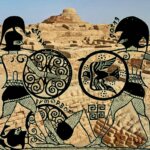The Vedas are one of the most important books in the Hindu religion. People say that they are some of the oldest books in the world. Legend says that Veda is where all knowledge and learning are kept. It is known that the Vedas are eternal and vibrate in the outer dimensions of the Brahmans’ world.
People think of them as the center of everything. The word “Veda” means “knowledge,” which is why people are here. The Vedas explain the why, what, and how of human life in a way that leads to Nirvana or freedom.
They are interested in what the Divine is all about, not just one God or idea. Sages of the past thought that the idea of “Vedas” had been around forever and was outside of time. Until the so-called Vedic Period of India lasted from 1500 BCE to 500 BCE, the Vedas were usually passed down orally from one generation to the next.
The Vedas are a collection of tens of thousands of songs that were given to people by God. They may come from a time when everyone spoke the same language, and there was no writing.
Most Vedas are hymns, which must be said with respect because of their spiritual value. The vibrations made by the chants help people feel better and get better. It could also be seen as a way to get better.
One interesting thing about the Vedas is that the sound of the mantras is just as important as the words. People say that the music and lyrics have stayed the same over time and have not changed or become contaminated. The Vedas tell us about the unknown and life lasting forever.
It has to do with how these unknown sense organs affect living things (jivas), the universe (Jagat), and God (Ishvara). Ancient saints and sages thought that nature and its energies were ways Brahma showed himself.
They explain how the universe came to be, how it stays together, and how it will end. The Vedas also talk about how the soul changes over time, including its fate, connection, and freedom. Both freedom and death are inevitable.
The Vedas are about bridging the gap between a super-sensual dimension that does not care about human intelligence and man’s normal state of awareness. The Vedas say that there is a deep link between matter and spirit, the cosmos and living things and that this link holds the answers to all of the world’s problems.
How were the Vedas put together ?
The four main parts of the Vedas are in order of when they were written. Please look at the list below to learn more about these parts or pieces:
The Samhitas
These are the oldest parts of the Vedas that we know about. They are mostly songs and prayers that praise God.
The Brahmanas
The Brahmanas are mostly a book of rituals and prayers that helps priests do their jobs.
The Aranyakash
Most of this section is about worship and meditation.
The Upanishads
The intellectual and spiritual teachings of Hinduism are found in the Upanishads.
Types of Vedas
The Samhita part of the Vedas can be divided into four groups.
1. Rigveda
This is the first form of the Veda. The Rigveda is a collection of 1028 hymns called “suttas” and 10 books called “mandalas.” According to tradition, the Rigveda was written between 1800 and 1100 BCE and is the first Vedic Sanskrit work. Rigveda means “Praise Knowledge” in English, and it is made up of about 10600 verses. Since they were written after books 2 and 9, Mandala 1 and 10 are the most recent Rigvedic books.
The earliest and shortest Rigvedic books are 2 through 7, sometimes called the “family book.” The hymns of the Rigveda talk about gods like Agni and Indra, and they are said to have been written by the sage rishi. Gayatri, Anushtubh, Trishtubh, and Jagati are all types of meters used to write Rigvedic hymns.
2. Samaveda
The Samaveda was written somewhere between 1200 and 800 BCE. Most of this Veda is about how to worship as a group. There are 1549 verses in the Samaveda, and 75 were copied from the Rigveda. The Samaveda is linked to the Kena and Chandogya Upanishads.
It is considered the basis of Indian classical music and dance because it has many beautiful hymns and chants. The Samaveda has been written down in three ways: Kauthuma, Ranayaniya, and Jaimaniya. Samaveda is not meant to be read. Instead, it is a musical score that must be heard.
3. Yajurveda
Yajurveda was written between 1100 and 800 BCE, at the same time as Samaveda. It is a collection of rituals, mantras, and chants for the Supreme Being and knowledge. Yajurveda means “worship of knowledge.” There are two kinds of Yajurveda: Krishna (black or dark) and Shukla (white or bright).
In Shukla Yajurveda, the verses are clear and well-organized. In Krishna Yajurveda, on the other hand, the verses are less clear and less organized. Most of the 1875 verses in the earliest version of this Veda came from Rigveda. There are four versions of the Krishna Yajurveda: the Taittiriya Samhita, the Maitrayani Samhita, the Katha Samhita, and the Kapishthala Samhita.
4. Atharvaveda
Attharveda was written between 1100 BCE and 800 BCE. The Atharvaveda talks about how people should act daily and their many responsibilities. It comprises 730 hymns (called sultans), 6000 mantras, and 20 volumes. Only the Saunakiya and the Paippalada are still around from the Atharvaveda.
This Veda is known for its magical formulas and has the Mundaka Upanishad, the Mandukya Upanishad, and the Prashna Upanishad. The twenty volumes are set up based on how long the hymns have been. The Atharvaveda is known for having different melodies than the Samaveda. Most of the hymns in these Vedas are magic spells or charms that people say to help themselves or make money.
Conclusion
The Vedas are about much more than just songs and prayers. They give life a purpose and a way to live that aligns with religion or dharma. They are the oldest written works in Sanskrit. But most of us have a disgusting lack of respect for our culture and history. So, the time has come to welcome this dormant part of Indian culture with open arms and look at life through a different lens.























Leave a Reply